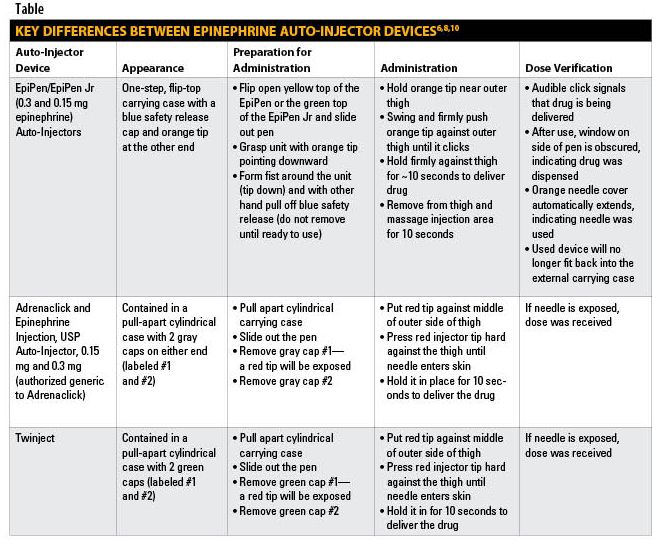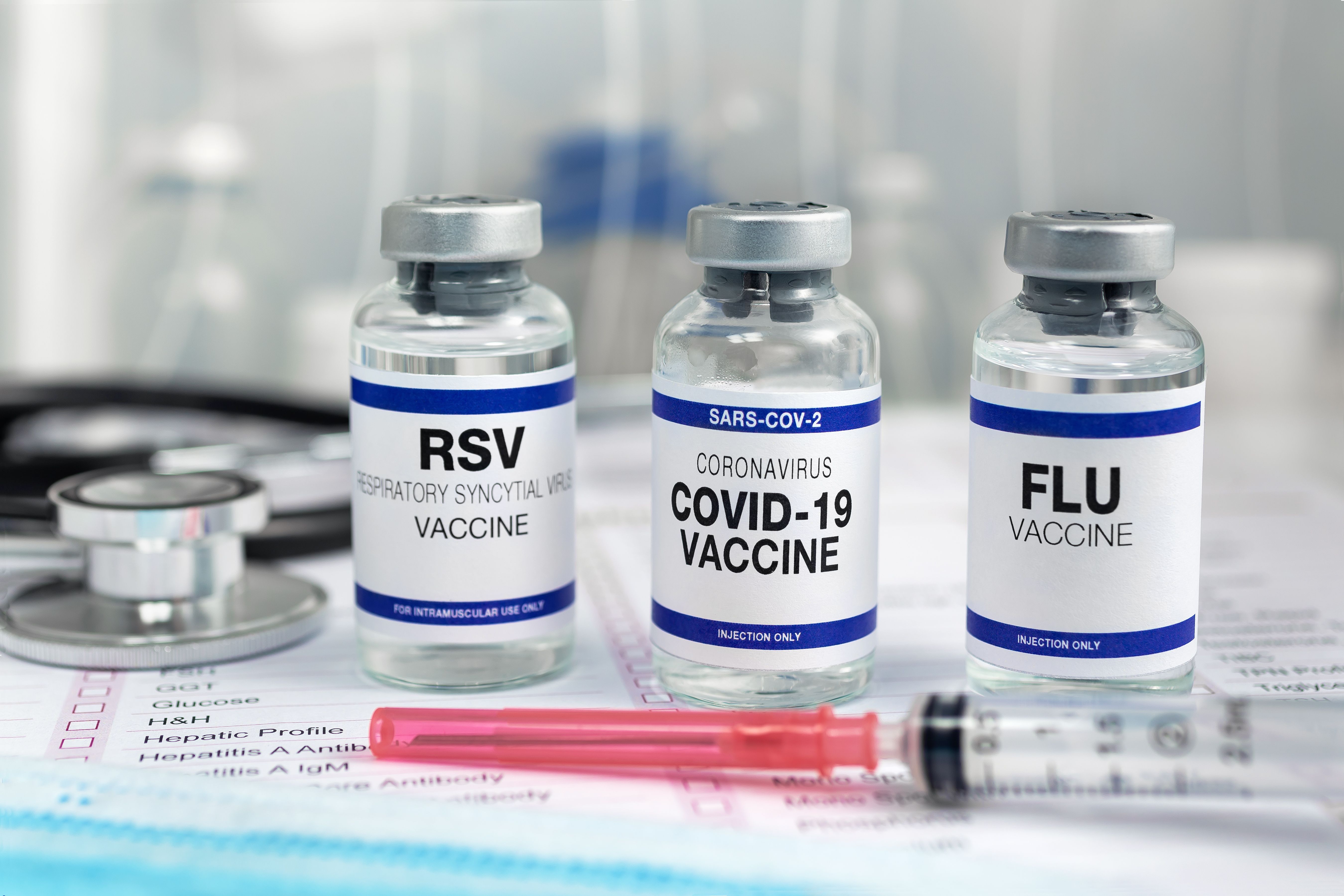Article
Important Considerations When Dispensing Epinephrine Auto-Injector Devices
Epinephrine is the cornerstone of emergency treatment for anaphylaxis, and pharmacists must ensure that their patients are familiar with and can properly use their auto-injector devices.
Anaphylaxis is a serious, systemic allergic reaction that is rapid in onset and can cause death.1,2 Epinephrine, the cornerstone of emergency treatment for anaphylaxis, helps relieve the life-threatening symptoms of anaphylaxis (eg, hypotension and shock, upper airway obstruction) via its alpha1-adrenergic effects.3,4 Delayed administration of epinephrine is associated with an increased risk of death.3,4 Because anaphylaxis often occurs in the community setting where health care providers are not present, it is essential for patients at risk for anaphylaxis and their caregivers to be educated regarding proper self-management strategies, including the appropriate administration technique for epinephrine autoinjector devices.1,3,5 Community pharmacists are easily accessible, which affords them the opportunity to counsel patients and their caregivers on appropriate self-management strategies so they are prepared in the event of an emergency.
Currently, 3 brands of epinephrine auto-injectors are available on the market—EpiPen Auto-Injector, Adrenaclick, and Twinject.6-8 EpiPen (available since the late 1980s) was the only epinephrine auto-injector available for the emergency treatment of anaphylaxis until the emergence of Adrenaclick and Twinject in the 2000s.9 As of March 2010, an authorized generic to Adrenaclick became available, marketed by Greenstone as “Epinephrine Injection, USP Auto- Injector.”10 An authorized generic is a pharmaceutical product that was originally marketed and sold by a brand company, but is relabeled and marketed under the generic product name.11 No generic version of EpiPen Auto-Injector, Twinject, or Adrenaclick exists at this time. EpiPen, Adrenaclick, Twinject, and the authorized generic to Adrenaclick have an FDA Orange Book rating of “BX,” indicating that insufficient evidence exists to determine therapeutic equivalence. This rating indicates that these epinephrine auto-injector products are not therapeutically equivalent to each other.9 For example, the other products should not be substituted and dispensed when EpiPen Auto-Injector is prescribed, unless the prescriber is consulted and agrees to change the prescription.
In addition to the lack of therapeutic equivalence among epinephrine auto-injector products, differences exist between the auto-injector devices’ appearance, administration technique, and dose verification (Table). It is important to understand these differences, as they may have important clinical implications for patients and their caregivers. For patients who have been using a particular brand, switching between products increases the likelihood that either the patient or caregiver may be confused when administering the injection, potentially leading to serious clinical outcomes, including death. For example, the EpiPen Auto-Injector requires the removal of only one cap to prepare for administration, while the authorized generic epinephrine autoinjector requires the removal of two caps. If the patient or caregiver attempts to prepare the authorized generic epinephrine auto-injector based on their experience with EpiPen Auto-Injector (removing only the second cap), they may not realize that the drug was not appropriately discharged. In addition, removing the second cap before removing the first cap may expose the patient to accidental needle sticks from the exposed needle.10,12 In order to avoid confusion, all patients and/or caregivers should be educated on epinephrine auto-injector devices and their proper administration techniques every time a prescription is picked up, confirming not only the instructions for use, but also the product being dispensed.

Role of the Pharmacist
Epinephrine auto-injector devices are used for the emergency treatment of potentially life-threatening anaphylactic reactions, and each has a unique design and operating instructions for use under stressful conditions. Therefore, it is critical that these agents be administered quickly and correctly, without the added confusion caused by the patient or caregiver being unfamiliar with a product. It is important for pharmacists to understand that although the newly available authorized generic epinephrine autoinjector is therapeutically equivalent to Adrenaclick, it is not an approved substitution for EpiPen Auto-Injector, EpiPen Jr Auto-Injector, or Twinject due to its BX Orange Book rating; only “A” rated products are considered bioequivalent, and thus, substitutable.9 Therefore, when presented with a prescription for an EpiPen Auto-Injector or another brand, it may be unlawful to dispense a different type of epinephrine auto-injector unless it is an A-rated generic, even if the prescriber indicates that substitution is permitted.
Regardless of the product dispensed, pharmacists should be familiar with key differences between all epinephrine auto-injectors and the implications of those differences for patients and their caregivers based on their existing knowledge and experience. As a result, pharmacists will be better able to communicate this information to patients, reducing the chance for confusion and potentially serious clinical consequences when prompt and accurate administration is necessary.
About EpiPen Auto-Injectors
Indications and Usage
EpiPen and EpiPen Jr Auto-Injectors (0.3 and 0.15 mg epinephrine) are indicated in the emergency treatment of type I allergic reactions, including anaphylaxis, to allergens; idiopathic and exercise-induced anaphylaxis; and for patients with a history or increased risk of anaphylactic reactions. Selection of the appropriate dosage strength is determined according to body weight.
Important Safety Information
EpiPen Auto-Injectors should only be injected into the anterolateral aspect of the thigh. DO NOT INJECT INTO BUTTOCK, OR INTRAVENOUSLY.
Epinephrine should be used with caution in patients with certain heart diseases, and in patients who are on drugs that may sensitize the heart to arrhythmias, because it may precipitate or aggravate angina pectoris and produce ventricular arrhythmias. Adverse reactions include transient moderate anxiety, apprehensiveness, restlessness, tremor, weakness, dizziness, sweating, palpitations, pallor, nausea and vomiting, headache, and/ or respiratory difficulties.
EpiPen and EpiPen Jr Auto-Injectors are intended for immediate self-administration as emergency supportive therapy only and are not intended as a substitute for immediate medical or hospital care.
Dr. Brice Labruzzo Mohundro is assistant professor at the Univeristy of Louisiana at Monroe College of Pharmacy, in Baton Rouge, Louisiana. Dr. Michael Marlan Mohundro is director of pharmacy at Our Lady of the Lake Regional Medical Center, in Baton Rouge, Louisiana.
This article was supported by Dey Pharma, L.P.





